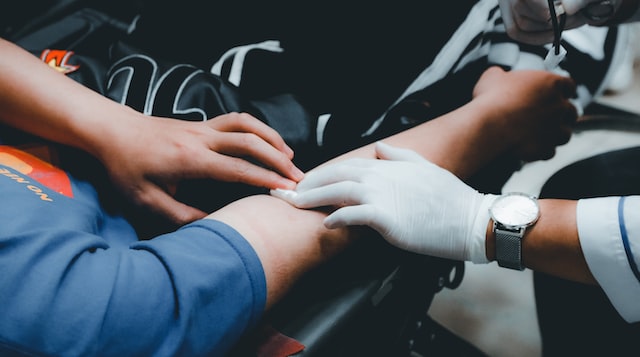The Byline Intelligence Team digs into the story of the past 70 years in data

The death of Queen Elizabeth II has led many people to reflect on the societal changes that took place during her 70 years on the throne.
When she succeeded her father at the age of 26, the UK was rebuilding post-war; the NHS was five years old; and while the population managed on rations, a mass house-building programme helped to transform the bombed-out cities of the Second World War.
Today, the NHS faces record waiting times and a staffing crisis; people struggle to feed their families as they choose between food and fuel; and house-building has stagnated, with council properties no longer a source of national pride, but often seen as a stigma, left to deteriorate.
The population in England and Wales when Princess Elizabeth became Queen was 43,955,000 – up 59,829,000 by 2020. Her death at 96 is part of a trend where people are living longer: the Queen sent more than 175,000 telegrams to centenarians in the UK and the Commonwealth.
Much has changed since 1952. The Byline Intelligence Team examined the pace of change over the past 70 years and asked: are we returning to the 1950s?
DON’T MISS A STORY
Sign up to email updates from Byline Times
Science and Medicine
Arguably the greatest leap forward in the past 70 years has been in the field of medical science. Illnesses that were once a death sentence are now survivable. While new diseases have developed since 1952 – most notably, Coronavirus and HIV/AIDS – within a remarkably short space of time we have seen treatments that allow many people with these deadly viruses to survive and live normal lives.
In 1952, the crude mortality rate for England and Wales was 1,131 per 100,000. In 2019 (before the pandemic), it was 893 per 100,000, representing a 26% decline. Life expectancy is now 81.6 years compared to 78 for a boy born in 1952, and 83 for a girl born the same year.
Today, one in two of us will get cancer in our lifetimes. It’s a scary number, but more of us are surviving the ‘big C’ than ever before. In 1972 – two decades after the Queen’s accession – only 45% of men diagnosed with cancer survived for more than a year in England and Wales, and 55% of women. By the time of her Golden Jubilee, in 2012, the number was 67% and 74% respectively. Half of people diagnosed with cancer will now survive for more than 10 years.
One of the big indicators of a healthy nation is maternal and infant mortality rates. Back in 1952, the infant mortality rate was 29 per 1,000 live births; by 2022 it had dropped to just under four deaths per 1,000 live births. Maternal mortality was 90 per 100,000 births in 1952. Fast forward 70 years and of the 2,173,810 women who gave birth in 2017-2019, 191 died during or up to six weeks after pregnancy, 495 during or up to one year after their pregnancy. This is, by any standards, a significant decline.
Social Change
Since 1952, the UK has seen the rise of three great social liberation movements: women’s rights, black liberation, and LGBTIQ liberation. Changes in the law, such the Race Relations Act in 1974 and the decriminalisation of homosexuality in 1967, have been accompanied by a rise in cultural visibility and improved equality.
A total of 107 women served as MPs in the entire period of 1953-1997: today we have 225 women MPs in a single Parliament and our third female Prime Minister.
Legal changes for women include the Equal Pay Act 1970, the criminalisation of rape in marriage in 1991, and the 1967 Abortion Act.
The labour market participation of women reached a record high of 74.2% in 2018 compared to 72.4% in 1952 (the lowest point was 65.9% in 1983).
Women don’t need to have a man’s signature on their bank account or mortgage application. In the eyes of the law, at least, women have equal rights.
It took until 1987 before the Queen saw two black MPs in Parliament: today there are no white men in the four great offices of state, and 65 black and ethnic minority MPs. Black and ethnic minority people are entering higher education at increasing rates: in 2022, 12.2% of first year students were Asian, 8.7% were black, 4.5% had mixed ethnicity, and 2% were from another ethnic minority group.
The New Labour Governments of 1997 and 2001 introduced gay liberation laws, including equal age of consent, an end to the ban on gay people in the military and gay adoption, and civil partnerships which later became equal marriage rights under David Cameron.
In 1952, the warning signs were there that the age of Empire was over. India became independent in 1947 and the post-war human rights settlement was putting pressure on the UK to end its policy of ‘legal lawlessness’ in colonial countries that were ruled with violence, racism and white supremacy.
During the Queen’s reign, 48 formerly colonial countries became independent, including numerous countries in Africa, the Middle East, and the Caribbean. The first was Sudan, in 1956.
Much has been made with the Queen’s relationship with countries around the world, including those which formerly made up the British Empire. One third of the Queen’s total overseas visits were to Commonwealth countries, and she attended 22 Commonwealth heads of government meetings as well as seven Commonwealth games. By the end of her reign, the Queen had visited all but two Commonwealth countries – Cameroon and Rwanda – making close to 200 trips.
But King Charles III may be presiding over fewer Commonwealth countries than his mother, as people across the realm question whether they want a British monarch to remain as their head of state. Barbados became a republic last year and Antigua and Barbuda are due to hold a referendum on breaking with the monarchy.
Poverty and Inequality
It’s challenging to track changing rates of poverty since 1952 due to the different ways in how it is measured. But there are indicators of where social mobility has improved – and where there has been regression.
When the Queen came to the throne, education was only compulsory up to the age of 15, and children’s futures were decided by the ’11+’ exam. Today, education and training is required up to the age of 19, and young people’s aspirations have shifted too. In 2019, 50% of young people went to university; back in 1954 it was 3.4%.
Workers’ rights are also an indication of a shift in equality: since 1952 numerous laws have been introduced to improve protections for workers such as the Health and Safety Act, and EU directives limiting working hours, protecting maternity rights, and supporting part-time workers.
All of this seems much to rejoice in. But not all metrics have improved.
Back to the 1950s?
One of the shocking regressions is in housing. You only have to watch Cathy Come Home or A Taste of Honey to understand the disturbing state of slum housing in mid-20th Century Britain. This crisis was met with mass house building – a need that was exacerbated by the destruction of thousands of homes in the Blitz – and those houses were built for the people.
In 1952, 260,000 houses were built, of which four-fifths were council properties. Compare that to 2020, when fewer than 7,000 social homes were built in England – that same year 27,036 households were recorded in the homelessness system.
The housing crisis is perhaps one the starkest reminders that, while much has improved for the UK in the past 70 years, the country is in a crisis that is arguably pushing it back to the 1950s.
Even those who have a roof over their heads are struggling to stay warm. The cost of living crisis is forcing vulnerable families to choose between food and fuel, with charities concerned about an increase in cold weather deaths. Despite various ‘boomer’ commentators claiming that living without central heating did them no harm, the rate of excess winter deaths in the 1950s was 60,000 – that decreased steadily in the intervening decades to 23,200 in 2018/2019. The decrease was fuelled by warmer homes, but is set to rise again.
The huge achievements of medical science cannot be underestimated but political decisions in recent years have led to record ambulance waiting times and more than 300,000 patients waiting a year for operations; a failure to meet cancer diagnosis and treatment targets; and the return of previously eradicated diseases. The polio vaccine was introduced in 1956 – today the virus has been detected in London.
Maternal mortality may have decreased dramatically, but in one area a persistent inequality remains: black and ethnic minority women are four times more likely to die in childbirth than their white peers. This speaks to a greater crisis in racial equality that impacts on everything from health outcomes to prison populations, school exclusion rates and violent death.
People from ethnic minority groups, especially Pakistani and Bangladeshi groups, are more likely than white British people to report limiting long-term illness and poor health. More than a quarter (27%) of the prison population are from an ethnic minority group, but only 13% of the UK population is black and ethnic minority. Exclusion rates for black Caribbean students in English schools are up to six times higher than those of their white peers in some local authorities.
While some in the country mourn the Queen, a community was also mourning the fatal shooting of Chris Kaba, a 24-year-old black man shot dead after rounds were fired from a police weapon. At least 154 people have been fatally shot by police between 1952 and 2021, with black men disproportionately killed in the latter decades. Up until the 1990s, the majority of fatal police shootings were in Northern Ireland. This data does include, for example, shooting terrorists during attacks such as in London Bridge, 2017.
Institutional misogyny continues to frustrate women’s equality. As for the other big liberation movement of the past 70 years – LGBTIQ rights – there has been a worrying rise in hate crime and a new Government determined to declare war on ‘wokery’ which appears to include attacks on sex, race and LGBTIQ equality.
The argument can clearly be made that institutionalised racism in the UK today has its roots in the Empire. But people continue to see the country’s imperial history as something to be proud of: a 2016 survey found that 43% of Britons surveyed said that the empire was a good thing, and 44% surveyed said they considered it to be a source of pride.
The decision to leave the European Union threatens progress on workers’ rights – with the laws created in the EU Social Chapter at risk of being scrapped by Liz Truss by the end of 2023. While most will be replaced with UK legislation, some may never return. This threat comes as the Government wages war on workers’ rights across the board, including by making it harder to take part in strike action.
The hard-won changes over the past 70 years by liberation movements, workers, and a commitment to the post-war social contract have rarely felt so fragile as they do today.

This article was produced by the Byline Intelligence Team – a collaborative investigative project formed by Byline Times with The Citizens. If you would like to find out more about the Intelligence Team and how to fund its work, click on the button below.
OUR JOURNALISM RELIES ON YOU
Byline Times is funded by its subscribers. Receive our monthly print edition and help to support fearless, independent journalism.


New to Byline Times? Find out more about us
SUBSCRIBE TO THE PRINT EDITION
A new type of newspaper – independent, fearless, outside the system. Fund a better media.
Don’t miss a story…
Our leading investigations include: empire & the culture war, Brexit, crony contracts, Russian interference, the Coronavirus pandemic, democracy in danger, and the crisis in British journalism. We also introduce new voices of colour in Our Lives Matter.









